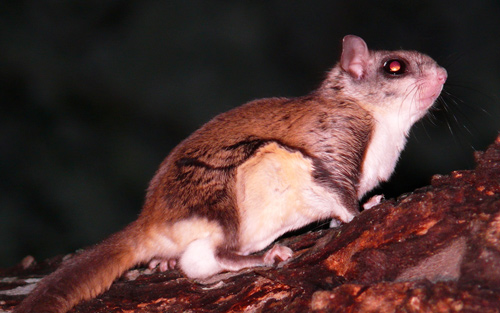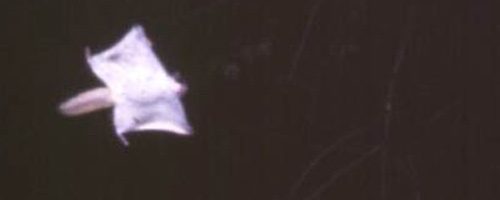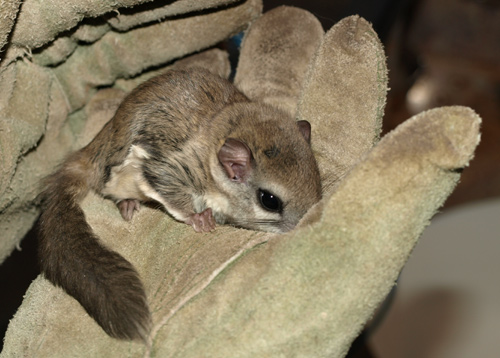Southern Flying Squirrels are the most common flying squirrel in Connecticut. The fur on top is grayish brown, the underbelly fur is white. Along their sides they have a flap of skin running between the front and back legs on the right and on the left called a patagium that is used for gliding. When the squirrel isn't "flying" this flap is scrunched up and may not be very noticable. They have a 3 to 4 inch tail that, unlike the Eastern Gray Squirrel's, isn't bushy. These are small squirrels, weighing between 1 and 4 oz. Their black eyes look large in proportion to their heads giving them a very cute, babyish appearance.
These squirrels range through the eastern half of the US (excepting Maine) in deciduous forest habitat. Their northern counterpart, which looks similar but is larger, may be present along the northern edges of the state. Southern Flying Squirrels are active year-round. In extremely cold weather they may become torpid and stay in their nests, but this is not true hibernation. They will nest in tree cavities and nesting boxes, and nest communally. As many as 50 squirrels have been found gathered in a winter nest. The group nesting habit helps to keep them warm in winter. The material used for nesting often contains lichens which the squirrels eat, especially over winter. Summer nests of leaf and twig bundles are built. These are much smaller than the large leaf nests created by the Eastern Gray Squirrel. Flying squirrels are nocturnal and therefore often go unseen by humans hosting them in their backyards.
Typical diet in the wild consists of tree nuts such as hickory nuts, beech nuts and acorns. Also fungi, lichens, berries, seed, eggs, along with some insects and carrion is eaten. These squirrels eat fungus on the ground and will dig down to get at the parts underground as well. They are much more agile in the trees and don't usually stray far from a tree trunk escape route.
These squirrels mate in late February/early March, and produce an early spring litter. A second litter may be produced in late summer.
Flying squirrels actually glide rather than fly. They stretch out their legs, pulling the skin flap called the patagium taut enough to act as a gliding sail. They have good judgement of distance and can steer around obstacles mid-glide. The glides can be as long as 50 ft, but are usually shorter from tree to nearby tree. The squirrels glide from a high point to a lower point. Mother squirrels can even transport babies while gliding.
Neat Fact
The Southern Flying Squirrel's scientific Latin name Glaucomys volans translates literally into Flying Gray Mouse. Glaucomys for gray mouse and volans for flying.


